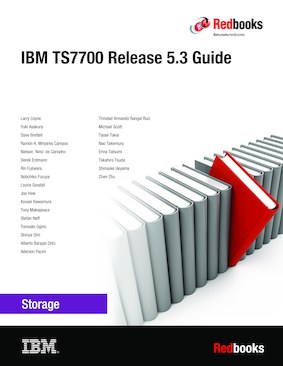IBM TS7700 Release 5.3 Guide
An IBM Redbooks publication
Note: A newer draft version of this publication is available

Published on 27 February 2024
ISBN-10: 0738419001
ISBN-13: 9780738419008
IBM Form #: SG24-8464-03
Authors: Larry Coyne, Yuki Asakura, Dave Brettell, Ramón A. Minjares Campos, Nielson ’Nino’ de Carvalho, Derek Erdmann, Rin Fujiwara, Nobuhiko Furuya, Lourie Goodall, Joe Hew, Kousei Kawamura, Tony Makepeace, Stefan Neff, Tomoaki Ogino, Shinya Ohri, Alberto Barajas Ortiz, Aderson Pacini, Trinidad Armando Rangel Ruiz, Michael Scott, Taisei Takai, Nao Takemura, Erina Tatsumi, Takahiro Tsuda, Shinsuke Ueyama and Chen Zhu
This IBM Redbooks® publication covers IBM TS7700 R5.3. The IBM TS7700 is part of a family of IBM Enterprise tape products. This book is intended for system architects and storage administrators who want to integrate their storage systems for optimal operation.
Building on over 25 years of experience, the R5.3 release includes many features that enable improved performance, usability, and security. Highlights include the IBM TS7700 Advanced Object Store, an all flash TS7770, grid resiliency enhancements, and Logical WORM retention.
By using the same hierarchical storage techniques, the TS7700 (TS7770 and TS7760) can also off load to object storage. Because object storage is cloud-based and accessible from different regions, the TS7700 Cloud Storage Tier support essentially allows the cloud to be an extension of the grid. As of this writing, the TS7700C supports the ability to off load to IBM Cloud Object Storage, Amazon S3, and RSTOR.
This publication explains features and concepts that are specific to the IBM TS7700 as of release R5.3. The R5.3 microcode level provides IBM TS7700 Cloud Storage Tier enhancements, IBM DS8000 Object Storage enhancements, Management Interface dual control security, and other smaller enhancements. The R5.3 microcode level can be installed on the IBM TS7770 and IBM TS7760 models only.
TS7700 provides tape virtualization for the IBM Z® environment. Off loading to physical tape behind a TS7700 is used by hundreds of organizations around the world.
New and existing capabilities of the TS7700 5.3 release includes the following highlights:
The TS7700T writes data by policy to physical tape through attachment to high-capacity, high-performance IBM TS1160, IBM TS1150, and IBM TS1140 tape drives that are installed in an IBM TS4500 or TS3500 tape library.
The TS7770 models are based on high-performance and redundant IBM Power9® technology. They provide improved performance for most IBM Z tape workloads when compared to the previous generations of IBM TS7700.
Part 1. Architecture and planning
Chapter 1. Introducing the IBM TS7700
Chapter 2. Architecture, components, and functional characteristics
Chapter 3. IBM TS7700 usage considerations
Chapter 4. Preinstallation planning and sizing
Chapter 5. Disaster recovery
Part 2. Implementation and migration
Chapter 6. Implementing IBM TS7700
Chapter 7. Hardware configurations and upgrade considerations
Chapter 8. Migration
Part 3. Operations
Chapter 9. IBM TS7700 Management Interface operations: Part 1
Chapter 10. IBM TS7700 Management Interface operations: Part 2
Chapter 11. IBM TS7700 common operations and procedures
Chapter 12. IBM z/OS host console operations
Chapter 13. Monitoring
Chapter 14. Performance considerations
Chapter 15. Copy Export
Chapter 16. Disaster recovery testing in a grid configuration
Chapter 17. RESTful API
Chapter 18. IBM TS7700 support for zTape Air-GAP
Appendix A. Feature codes and requests for price quotations
Appendix B. IBM TS7700 implementation for IBM z/VM, IBM z/VSE, and IBM z/TPF environments
Appendix C. JES3 examples and information
Appendix D. DEVSERV QLIB command
Appendix E. Sample job control language
Appendix F. Library Manager volume categories
Appendix G. IBM TS7700 parameter examples
Appendix H. Extra IODF examples
Appendix I. Case study for logical partitioning of a two-cluster grid
Appendix J. Configuring externally managed encryption